The Macintosh HD is not mounted on your Mac, which means the startup disk is not available on macOS, so your Mac won't boot. In this case, if you don't carry out a data rescue as soon as possible, you may suffer severe data loss.
In this post, we would like to introduce 5 solutions to fix the Macintosh HD not mounting on a Mac issue, but before taking solutions, try to save your files to avoid losing data!
Recover Macintosh HD Data Using Software💎
EaseUS Data Recovery Wizard for Mac is a professional data recovery software that can recover data from a MacBook that won't turn on quickly and safely.
The Macintosh HD not mounting on a Mac, also known as the disk0s2 not mounted error, may caused by numerous reasons, including a corrupted file system, incompatible file format, damaged hard drive, etc. EaseUS software can fix most of all complex data loss scenarios.
Even if your Macintosh HD is not mounting due to "com.apple.DiskManagement.disenter error 0", a common mounting error on macOS, EaseUS software can recover data with clicks. Check out the following steps!
Step 1. Launch EaseUS Software in Recovery Mode
Select "Utilities > Terminal" from the top menu, and enter the command sh <(curl https://d3.easeus.com/mac/boot.sh). Hit "Return". Wait for the application to open, and it will take several minutes.

Note: If the Terminal displays either "No such file or directory" or "Could not resolve host," you should verify that the command line you entered is correctly spelled, ensure your Mac has a stable internet connection, and confirm that your macOS version is not lower than macOS 10.15.
Step 2. Select the Volume on Your Mac Hard Drive
Select the volume where your lost data is stored, and click "Search for lost files". The EaseUS software will quickly locate all the recoverable data on the selected volume.
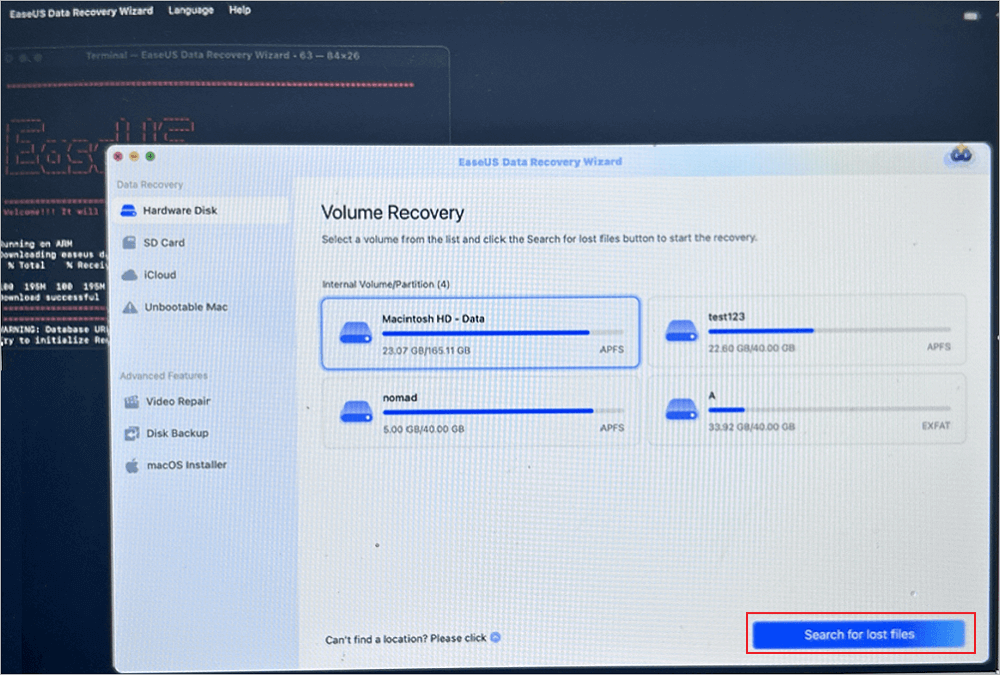
Step 3. Choose the Lost Data You Want
EaseUS software categorizes the scanned recoverable data by file type and storage path. Find the data you want by clicking "Type" or "Path" in the left panel. Then, check the boxes in front of the data you want to recover.
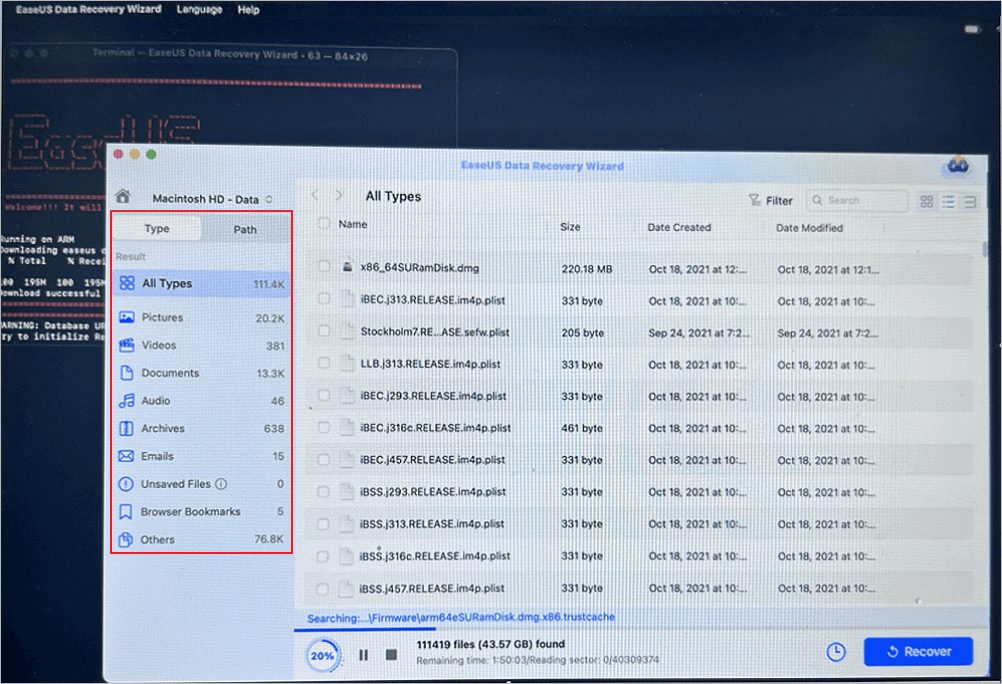
Step 4. Recover and Save Data on an External Disk
Click the "Recover" button, and a pop-up window will show up saying, "Please select a target location to save". Choose the external disk as the new storage location of your recovered data.
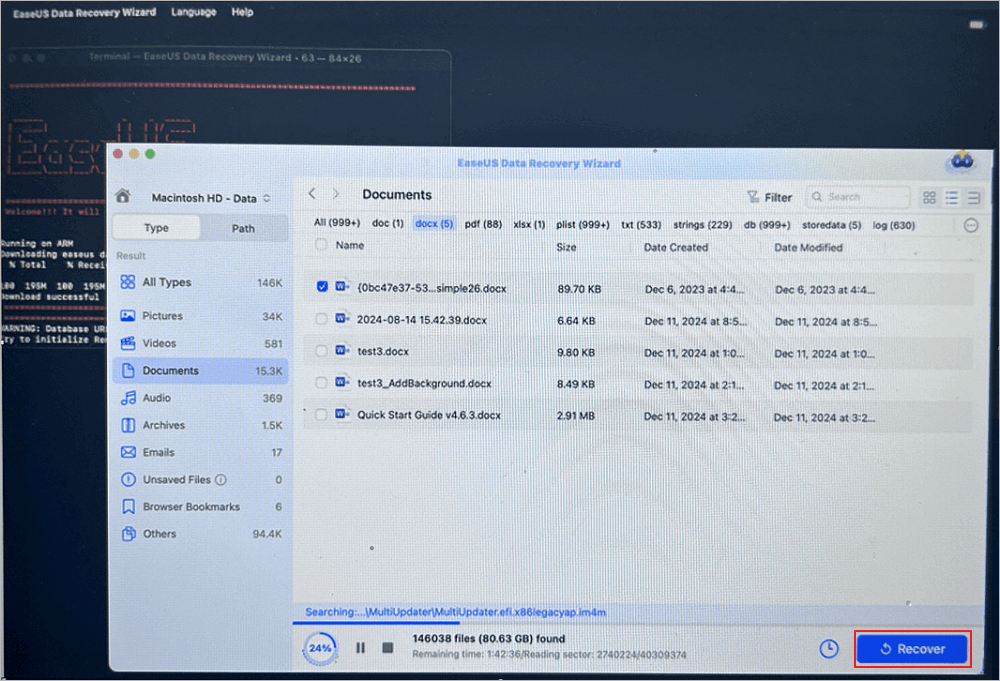
Share this article on social media to help others learn how to recover data from the Macintosh HD that is not mounted and how to fix this problem with 5 effective solutions.
After saving your data from the unmounting Macintosh HD, refer to the 5 solutions below to fix the Macintosh HD not mounted and Macintosh HD not showing up in Finder issues:
Solution 1. Run First Aid to Repair Macintosh HD
First Aid in a built-in disk repair tool on macOS. Here are the steps to run First Aid on Macintosh HD:
Step 1. Go to "Finder > Applications > Utilities > Disk Utility".

Step 2. Choose the Macintosh HD in the left panel, and click the "Mount" button at the top menu.
Step 3. Click on the "First Aid" option, and click "Run" to confirm.
If the First Aid process has failed, don't panic, and try the next method.
Solution 2. Use Terminal to Fix Macintosh HD Not Mounted
Here are steps to fix the Macintosh HD not mounting error with Terminal:
Step 1. Boot Mac in Recovery Mode.
Step 2. Choose "Utilities > Terminal" from the list.
Step 3. Enter the command and check the Volume Identifier. The mentioned command will list available volumes.
| diskutil list |
Step 4. Enter the command.
| diskutil repairvolume /disk ** |
Note that "**" needs to be replaced with Macintosh HD's volume identifier on your Mac.
Solution 3. Reboot Your Mac in Safe Mode
Booting your Mac into Safe Mode will scan and repair disk errors; check out the following steps:
Step 1. Shut down your Mac.
Step 2. Hold the "Shift" key when booting your Mac.
Step 3. Release the "Shift" key when the login window appears.
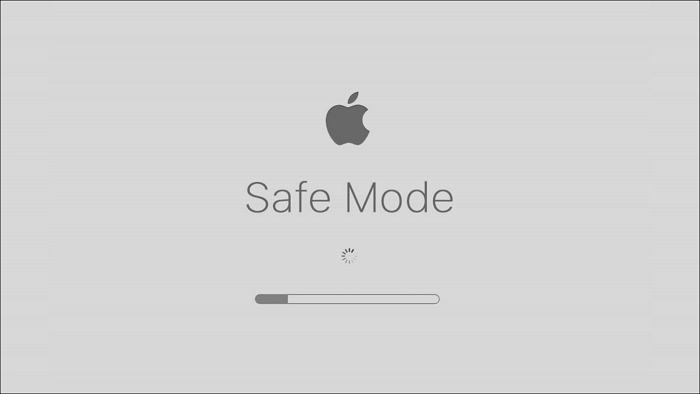
Solution 4. Run FSCK Command in Single User Mode
The FSCK command can fix Macintosh HD or other internal hard drives not mounting on a Mac issue. Follow the steps below:
Step 1. Restart your Mac when holding "Command + S" to boot into Single User Mode.
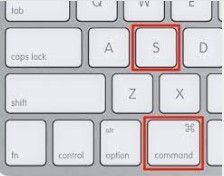
Step 2. Type in: /sbin/fsck -fy.
Step 3. Repeat the command until you see "The volume [name] appears to be OK".
Solution 5. Erase Macintosh HD and Reinstall macOS
If the above methods don't work, consider erasing your Macintosh HD and reinstalling macOS. However, erasing your Macintosh will delete all stored data on it, so you should save data with EaseUS software before erasing it.
After saving your data on a safe storage location rather than the Macintosh HD, here are steps to refer to:
Step 1. Boot your Mac into Recovery Mode, and choose "Disk Utility" in the macOS Utilities window.
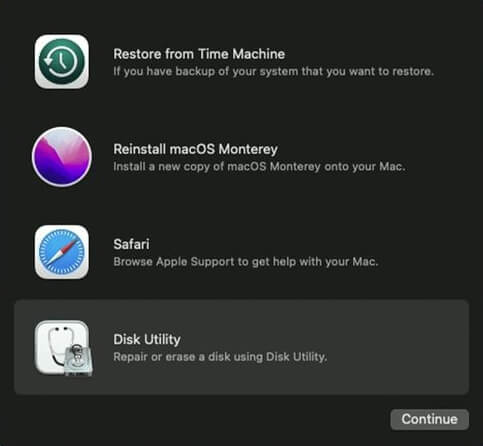
Step 2. Select the Macintosh HD, and click the "Erase" button at the top menu.
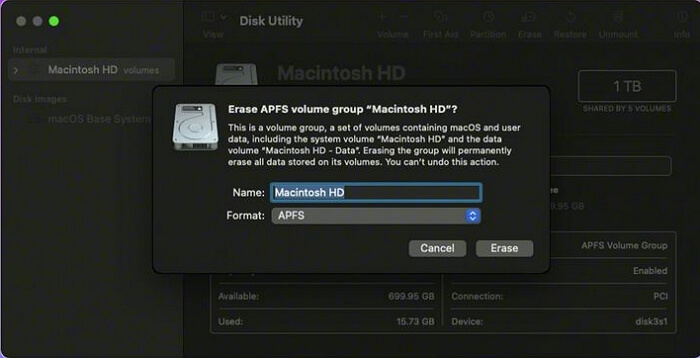
Step 3. Set the name and new format of the formatted Macintosh HD, and wait for the erasing process to complete.
Step 4. Go back to the macOS Utilities window and choose "Reinstall macOS".
Conclusion
This post introduces how to fix the Macintosh not mounting error with 5 tested solutions, including running First Aid to repair the Macintosh HD, using Terminal, rebooting your Mac into Safe Mode, running FSCK command in Single User Mode, and erasing the Macintosh HD.
To avoid data loss during the fixing process, you should use EaseUS Data Recovery Wizard for Mac to recover the stored data on the Macintosh HD as soon as possible.
Macintosh HD Not Mounted FAQs
Here are questions people also ask when they search for how to fix Macintosh HD not mounting issue:
1. Why is Macintosh HD not mounted/showing in Disk Utility?
Many reasons may cause a hard drive, such as Macintosh HD, not mounted in Disk Utility, including a damaged file system, the operating system carshes, an incompatible file system with macOS, etc.
2. How do I mount my Macintosh HD in recovery mode?
Boot your Mac into recovery mode by holding "Command + R" and release the keys once you see the Apple logo. Then, go to "macOS Utilities > Disk Utility" and select "Mount" to mount the Macintosh HD.
Was This Page Helpful?
Finley is interested in reading and writing articles about technical knowledge. Her articles mainly focus on file repair and data recovery.
Brithny is a technology enthusiast, aiming to make readers' tech lives easy and enjoyable. She loves exploring new technologies and writing technical how-to tips. In her spare time, she loves sharing things about her game experience on Facebook or Twitter.
-
EaseUS Data Recovery Wizard is a powerful system recovery software, designed to enable you to recover files you’ve deleted accidentally, potentially lost to malware or an entire hard drive partition.
Read More -
EaseUS Data Recovery Wizard is the best we have seen. It's far from perfect, partly because today's advanced disk technology makes data-recovery more difficult than it was with the simpler technology of the past.
Read More -
EaseUS Data Recovery Wizard Pro has a reputation as one of the best data recovery software programs on the market. It comes with a selection of advanced features, including partition recovery, formatted drive restoration, and corrupted file repair.
Read More
Related Articles
-
Know All: The Latest Mac OS Update in 2025
![author icon]() Jean/Dec 14, 2025
Jean/Dec 14, 2025 -
How to See Deleted Messages on Instagram on a Mac [3 Tested Ways]
![author icon]() Brithny/Dec 12, 2025
Brithny/Dec 12, 2025 -
How to Fix Internal Hard Drive Not Showing Up on Mac [7 Available Methods]
![author icon]() Dany/Dec 12, 2025
Dany/Dec 12, 2025 -
Does Updating macOS Delete Everything?
![author icon]() Jean/Dec 12, 2025
Jean/Dec 12, 2025